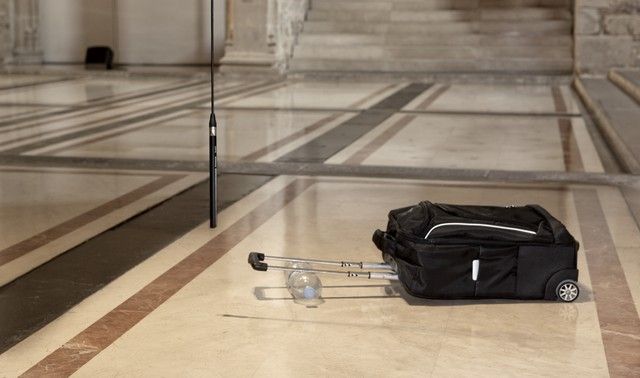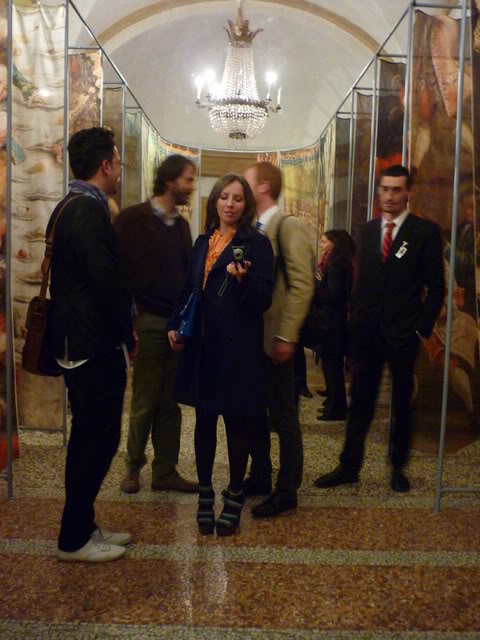
I had a few hours to kill in between a lovely lunch date and a radio recording at the BBC yesterday, so I thought I'd amble around inspecting exhibitions in Fitzrovia. Just my luck that most of the area's galleries were in change-over mode, getting ready to open new shows tonight, so I mostly just wandered around looking in windows at exhibitions not-yet-open. There's actually something quite pleasant about window-shopping exhibitions while they're still being set up: Alessandro Raho at Alison Jaques and Hot Tools at Libby Sellers didn't look that inviting; Clare Woods at Stuart Shave, maybe; I can't even remember what was going on at Haunch of Venison…
I walked past one glass-fronted space on Eastcastle Street and did a double take. An open gallery! Nice. But, oh no, oh god: it's Carroll / Fletcher. What to do? What to do? Go in and leave depressed, like last time, or give it a go and see what happens. I opted for the latter, because, well, because I'm like that; I took a deep breath and plunged into the icy chill of an air-conditioned concrete box.
And you know what? It was fan-flipping-tastic. I'm not even joking. I've adopted a new practice of not reading press releases until I'm on my way out of the gallery, which increases the possibility of my not being pissed off with a show by the incomprehensible twaddle written therein before I've so much as looked at a single work. It seems to help.
Anyway, so this show. Natascha Sadr Haghighian (who borrows her bios from bioswop.net as a rejection of CVs, bios, institutionalised regimes of knowledge, etc.!), hasn't made any new works for C/F, but installed a selection of pieces made over the last fifteen years. I find myself more and more approving of such a practice, as it means you get to see the best thoughts from, in this case, a clearly thoughtful mind, spread out for your enjoyment, rather than one amazing thought and lots of other not-so-good thoughts jammed together in a space because they all purport to tow the same thematic line.
In the first room, a suitcase crushes a bottle of water, the sound of which is amplified throughout the space. The sounds are nice, if the work is perhaps a bit too obvious in its attempt to say something new about the ridiculousness of airport security measures, but I found myself willing to forgive after walking into the "appendix" room next door. I've rarely seen work by artists which makes use of freedom of information requests, but it's a hugely effective and surprisingly powerful visual tool, particularly when accompanied by documentary-style photographs. The piece moves on from the farce of airport security, but sticks to water, with its investigation of Buxton's natural spring and the local council's decision to sell the rights to Nestle, thus jeopardising its townspeoples right to the spring. Like an exquisitely-crafted poem, a few simple pieces tell a striking story of one town's potential folly in selling its natural resources to a mega-corporate in exchange for what seems to be, as outlined by the FOI request, a pitifully small amount of cash.

The other piece which stuck with me was a microscope with its eyepiece replaced by a speaker. I walked up to the microscope, on its shiny silver cart, and dutifully wedged my eye up to the eyepiece only to realise I could see nothing but black. What's going on here, I snorted. Why can't I see anything. Just then, a strange - almost hyper auto-tuned voice - started singing "every breath you take…" from the microscope. Where in the hell is that coming from? Oh, that's clever. Ridiculous, but clever. I turned my head and put my ear against the eyepiece, which wasn't an eyepiece at all, but the squishy, soft bit from a pair of old-fashioned headphones.
But the best bit about the microscope piece was a little grey booklet sitting beside it. Inside the booklet, an interview with Haghighian asking questions of Evelyn Fox-Keller, professor of History and Philosophy of Science at MIT (who commissioned the piece in 2006). Fox-Keller is author of numerous books, The Biological Gaze among them, in which she examines how the concept of looking helps to determine what the scientist sees when he looks into the microscope. The conversation between the two is absolutely fascinating, particularly in that Fox-Keller's research takes questions of socially constructed meaning into account when considering the already sticky situation of perception and reality presented by physics (some of which I was trying to get at in my last exhibition, Pink Does Not Exist). Or as it's framed in the discussion: how we construct our realities as a hybrid of what one sees with the mind's eye (as something potentially influenced by meanings of looking) rather than the body's eye (the problem of perception as reality).
Like any good critic, I'm ignoring the works that I didn't really care for: schnitte (cuts), Julien Maire does this sort of thing with far more skill and spectacle; vice/virtue, which felt intellectually insignificant compared to the more thoughtful works in the show. On the whole, though, Haghighian's works are an eloquent pean to the power of research in artistic practice.



